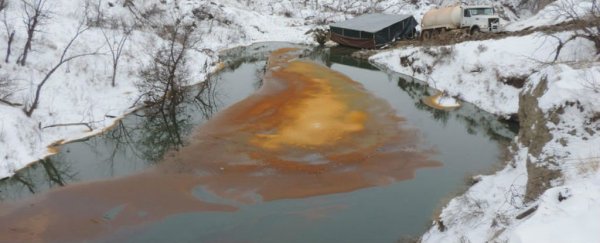With the highly controversial Dakota Access Pipeline expected to start operations this week, the latest reports on the state's oil spill record do not bode well. According to the North Dakota Department of Health, they've experienced more than 700 oil spills in the past 12 months alone.
Not only that, but reports of a major spill last December were found to be grossly underestimated - three times more oil leaked into the environment than we thought, making it one of the largest oil spills in North Dakota history.
According to Chris Clarke at KCET, if you averaged out all the oil spills in the state of North Dakota in the year ending on 1 May 2017, you'd have one spill every 11 hours and 45 minutes.
And we're not talking small leaks here. One event on the 18 May 2016 saw 400 barrels of oil (16,800 gallons) leak out in Bowman County, spreading more than 100 metres outside the refinery gates and into the surrounding environment.
That same event saw an additional 2,500 barrels (1 million gallons) of brine leak outside the facility.
But here's the thing - if those figures sound alarming, they're nothing compared to the more recent oil spill that occurred in Billings County, just 2.5 hours away from where the Standing Rock protest took place.
Back in December, it was reported that the Billings Country spill leaked 176,000 gallons of crude oil (4,200 barrels) into Ash Coulee Creek and the surrounding countryside, due to a fault in the Belle Fourche Pipeline.
Especially concerning for locals was the fact that the company that owns the leaky pipeline, Belle Fourche Pipeline Co., didn't even realise it was happening until a member of the public stumbled on the leak and notified them about it.
And that was five days after the leak had originally sprung.
By that stage, the oil had spread almost 7 km (5.4 miles) from the original leakage point.
Now, new reports on the event have shown that we didn't even know the half of it - turns out, the spill actually totalled 529,830 gallons of oil (12,615 barrels).
So yes, we're talking about more than half a million gallons of oil leaking out into privately owned land and US Forest Service grazing land, making it one of the largest oil spills in North Dakota history.
And, as Clarke at KCET points out, there's a good chance the contamination spread far and wide, with the company admitting in March that it had only managed to clean up a few thousand barrels.
"Ash Coulee Creek, near Belfield in southwestern North Dakota, is a tributary of the Little Missouri River, which flows into the main stem Missouri River at Lake Sakakawea," says Clarke.
"Cleanup continues: in … March, Bell Fourche reported it had recovered only 4,000 barrels of oil from the creek, and that workers had set the floating oil on fire more than 1,200 times since December."
The sad thing is this hasn't even been a particularly bad 12 months for North Dakota. It's had a history of oil spills for years. Between 2006 and 2014, there have been more than 1,300 pipeline spills in the state, according to The New York Times.
The two largest even hit the 1 million gallons mark, with one spill resulting in 1 million gallons (23,800 barrels) of oil being leaked into the county of McKenzie in 2006, and it happened again in 2014, when McKenzie experienced a leak of 1,008,000 gallons of oil.
One event on 29 September 2013 resulted in 20,600 barrels (865,200 gallons) of oil leaking from a pipeline in Mountrail County.
That event also wasn't detected by the pipeline owners. The owner of a local wheatfield was the first notice when his crops had become so contaminated, he could smell the oil.
So yes, there's reason to be concerned about the Dakota Access Pipeline, which has been built under the Missouri River near the primary water source of the Standing Rock Sioux tribe.
If we've learnt anything from history, it's that these pipes have not been nearly as secure as they should be - and spill detection methods have left a lot to be desired.
Our only hope at this stage is that Dakota Access bucks this extremely worrying trend.
